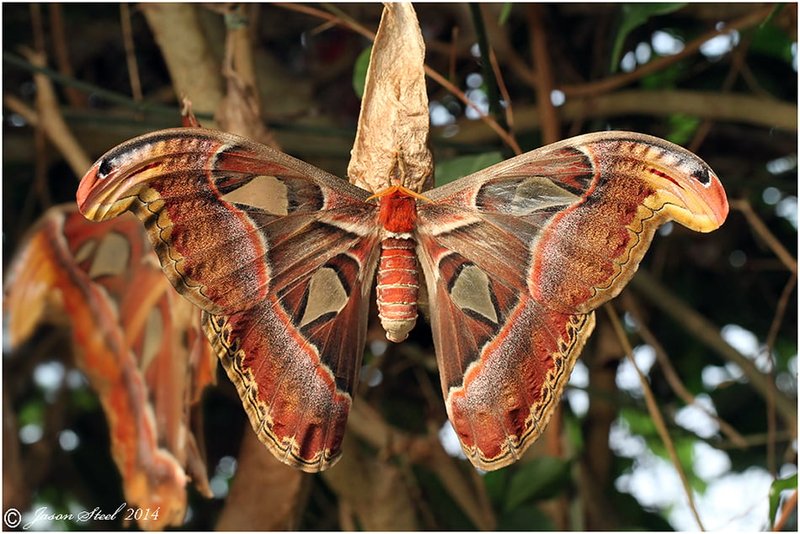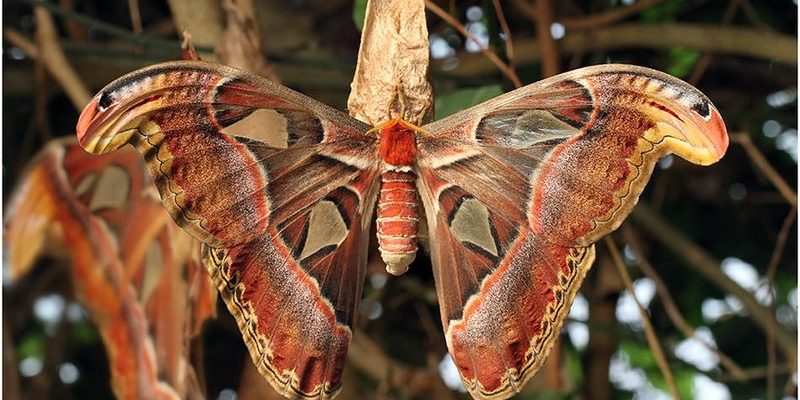
The Atlas Moth is nothing short of breathtaking. Imagine a creature with wings that can stretch up to 12 inches wide, making it one of the largest moths on the planet. It’s like holding a piece of art right in your hand, with stunning patterns and colors that seem to dance in the light. If you’ve ever glimpsed a giant butterfly in a garden or museum, you can only begin to imagine the awe you’d feel seeing the Atlas Moth in the wild.
This majestic insect isn’t just about looks. The Atlas Moth hails from the tropical forests of Southeast Asia, fluttering through the foliage in search of mates and sustenance. So what makes this moth so special? From its impressive size to its unique behaviors and life cycle, there’s plenty to explore. Join me as we dive into the enchanting world of the Atlas Moth!
Physical Characteristics
The Atlas Moth is striking for several reasons, with its wings being the most notable feature. The upper side of the wings displays a rich tapestry of brown, orange, and cream colors, which helps it camouflage against tree bark. This adaptation is crucial for avoiding predators. The patterns on the wings can also resemble the eyes of snakes, serving as a fascinating defense mechanism. When threatened, the moth can spread its wings wide, displaying these “eyes” to frighten away attackers.
Another extraordinary aspect is its size. Depending on the individual, the Atlas Moth can reach up to 12 inches across, making it the largest moth in the world by wingspan. Imagine a piece of fabric billowing in the wind; that’s the effect an Atlas Moth has as it glides through its natural habitat. Additionally, these moths have long, tail-like extensions on their wings, which not only add to their beauty but may also assist in gliding.
Color and Patterns
The colors of the Atlas Moth aren’t just random; they play a pivotal role in its survival. The earthy tones blend seamlessly with the foliage of the rainforest, serving as camouflage against birds and other predators. Also, the patterns can vary by region, with some moths showcasing vibrant oranges and yellows, while others might lean towards deeper browns and reds. This variation not only aids in their survival but also makes them a favorite among collectors.
Habitat and Distribution
You’ll find the Atlas Moth predominantly in tropical and subtropical regions of Southeast Asia. Countries like Malaysia, Indonesia, and India are prime habitats, where lush rainforests provide both food and shelter. The moth thrives in humid environments, often fluttering near the forest floor or high in the canopy, depending on the availability of mates and food sources.
Interestingly, the Atlas Moth has adapted well to different microhabitats within these regions. For instance, you might find them near streams and rivers, where the moisture levels are higher, supporting their lifecycle needs. The dense vegetation not only provides camouflage but also offers plenty of thriving plants that serve as food sources during the larval stage.
Environmental Importance
The Atlas Moth plays a significant role in its ecosystem. As a pollinator, it contributes to the reproduction of various plants in its habitat. While it primarily feeds on the leaves of certain host plants as a caterpillar, adult moths do not eat much, relying instead on moisture from sources like fruit juices. This behavior helps in spreading plant pollen, supporting biodiversity within the ecosystem.
Diet and Feeding Behavior
The diet of the Atlas Moth is intriguing due to its significant transformation from caterpillar to adult. In the larval stage, these caterpillars are voracious eaters, often munching on the leaves of specific host plants. Their favorites include the Guava, Citrus, and various species of fig trees. This diet is crucial for their growth, enabling them to store energy that will be vital as they transition into adulthood.
Once they metamorphose into adults, the feeding behavior changes dramatically. Interestingly, adult Atlas Moths do not feed on traditional nectar like many butterflies do. Instead, they seek out moisture and nutrients from sources such as rotting fruit, tree sap, and even the urine of animals. This unique feeding strategy helps them sustain their life without the need for flowers, making them quite adaptable.
Life Cycle of the Atlas Moth
The life cycle of the Atlas Moth is fascinating and showcases nature’s wonders. It begins with the female moth laying around 100 to 300 eggs on the underside of host plant leaves. These tiny eggs hatch into caterpillars, which undergo several molts, growing rapidly as they consume leaves. This growth phase can last several weeks, and once they reach full size, they enter the pupal stage, where they form a chrysalis.
Behavioral Traits
Atlas Moths are mostly nocturnal, emerging at dusk or during the night to mate and explore their surroundings. This behavior helps them avoid many daytime predators who may be on the lookout for their vibrant colors. Their mating rituals can be quite elaborate, with males often flying long distances to locate a female. Once they find each other, the courtship displays can last several hours, involving intricate wing flutters and patterns.
Another interesting trait is their short lifespan. While they’re busy making the most of their time, adult Atlas Moths typically live only a few weeks. This brief time frame is focused primarily on reproduction, emphasizing the urgency in their behaviors and interactions. You might think of it as a “live fast, love hard” philosophy!
Predators and Survival Strategies
Despite their large size, the Atlas Moth is still vulnerable to predators. Birds, bats, and even some reptiles see them as a meal. To combat this, the Atlas Moth employs various survival strategies. As mentioned earlier, their coloration aids in camouflage, but when threatened, they can also deploy another trick: they release a strong, musty odor to ward off would-be predators. It’s nature’s way of saying, “Stay away!”
Conservation Status
Currently, the Atlas Moth is not considered endangered, but it does face threats from habitat loss due to deforestation and human encroachment. As their natural habitats shrink, these remarkable moths become more vulnerable. Conservation efforts in Southeast Asia focus on protecting rainforests and promoting ecological balance, which helps ensure the Atlas Moth continues to thrive.
Individuals can also help by supporting sustainable practices, like reducing plastic use and advocating for wildlife conservation. Every little effort counts when it comes to protecting the habitats of these magnificent creatures. It’s a way of saying, “I care about the future of our planet,” and that’s a beautiful thing.
Interesting Facts
- The Atlas Moth can fly up to a meter high.
- They are named after the Titan Atlas from Greek mythology due to their enormous wingspan.
- Unlike many other moths, they produce very little sound when flying.
- Some locals even use Atlas Moth pupae to create art and crafts.
FAQ
What is the lifespan of an Atlas Moth?
The lifespan of an Atlas Moth is relatively short, averaging around two weeks to one month as adults. Their primary focus during this time is to mate and reproduce. Once they lay their eggs, their life cycle comes to a close, which emphasizes the intensity of their brief existence.
How do Atlas Moths find each other to mate?
Males use pheromones, chemical signals released into the air, to locate females. The scent can travel significant distances, allowing males to find potential mates even from afar. Once they detect the pheromones, they engage in intricate flying patterns to attract the female’s attention.
Are Atlas Moths harmful to humans?
No, Atlas Moths pose no harm to humans. Though their size might be intimidating, they are harmless and not known to bite or sting. They are more concerned with avoiding predators and finding mates than bothering humans.
Can Atlas Moths be kept as pets?
While some enthusiasts try to keep Atlas Moths, they are not ideal pets. Their short lifespan and specific habitat requirements make it challenging to care for them properly. Instead, enjoying their beauty in the wild or in butterfly sanctuaries is recommended.
Do Atlas Moths migrate?
Unlike some butterflies, Atlas Moths do not migrate long distances. Their movement is typically localized, staying within the vicinity of their habitat to find food and mates. They rely on their remarkable camouflage to survive in their chosen environment rather than undertaking migration.
What plants do Atlas Moth caterpillars eat?
Atlas Moth caterpillars primarily feed on the leaves of tropical trees, including species like Guava, Citrus, and Ficus. These host plants provide the necessary nutrients for their growth and development before they transition into their adult form.
Where can I see Atlas Moths in the wild?
Atlas Moths are found in tropical regions of Southeast Asia. If you’re visiting countries like Malaysia or Indonesia, consider exploring rainforests or butterfly reserves where these stunning moths might be spotted fluttering among the trees.
Are there any threats to the Atlas Moth?
Yes, the Atlas Moth faces threats primarily from habitat loss due to deforestation and human activities. Protecting their natural environments is crucial for the survival of this magnificent species. Community efforts and conservation initiatives can help maintain their populations.
Can Atlas Moths reproduce multiple times?
No, Atlas Moths typically reproduce only once in their short lifespan. After mating, females lay eggs, and then they die shortly after. This reproductive strategy focuses on ensuring their species continues without the need for multiple mating cycles.
How do I attract Atlas Moths to my garden?
Attracting Atlas Moths may be challenging, but you can create an inviting habitat by planting native tropical plants that serve as host plants for their caterpillars. Providing a moist area with plenty of shade can make your garden more appealing to these beautiful moths!
Are Atlas Moths endangered?
Currently, Atlas Moths are not classified as endangered. However, they face threats from habitat loss. Conservation efforts are crucial to maintaining their populations and ensuring these majestic creatures continue to grace our planet.

